


Colorful compounds of molybdenum
Some transition metal elements are well known for their colorful aqueous chemistry. Most notably the elements chromium and vanadium are known for their colorful and rich aqueous chemistry. In this webpage, it is demonstrated that molybdenum shows an equally colorful aqueous chemistry. The main difference with the other two elements is that the chemistry of molybdenum is more obscure and less well understood. So, this page just is a demonstration of what kind of colors can be obtained from molybdenum compounds, the explanation of the underlying chemistry unfortunately is not as detailed as one could wish.
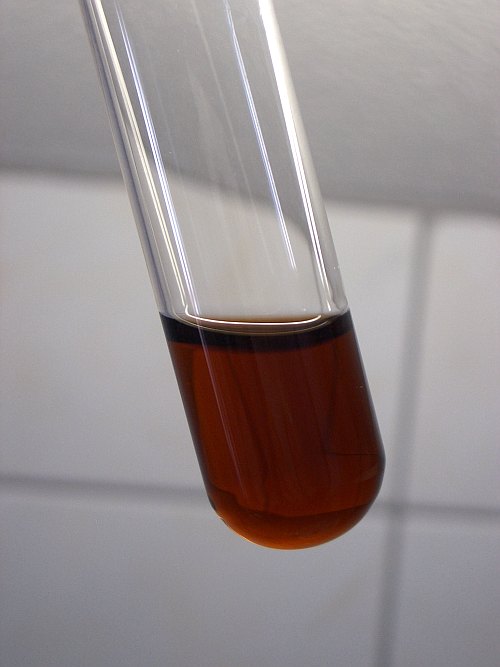
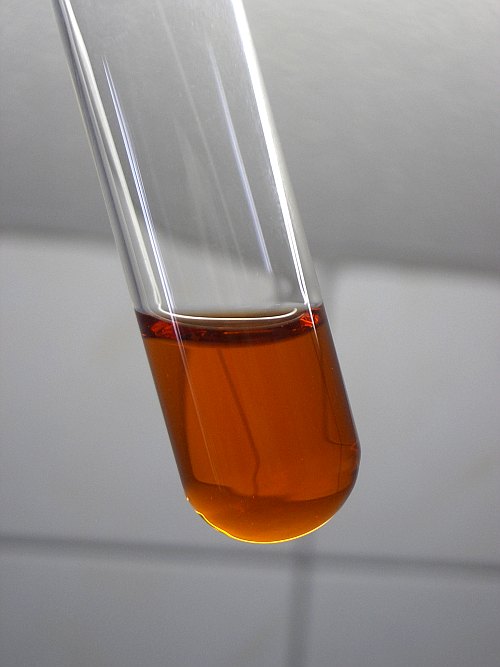
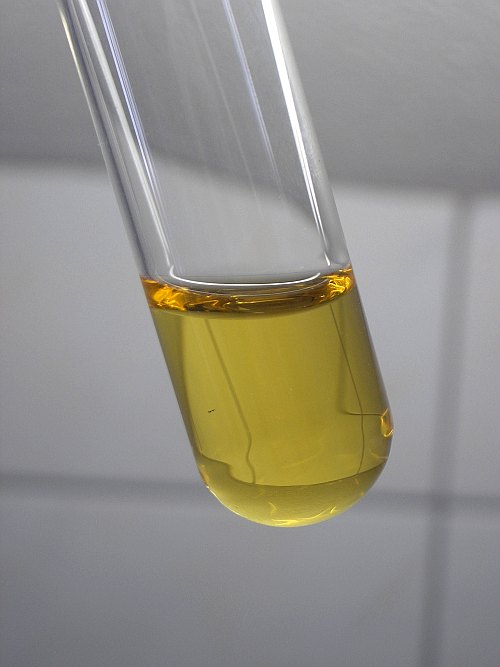
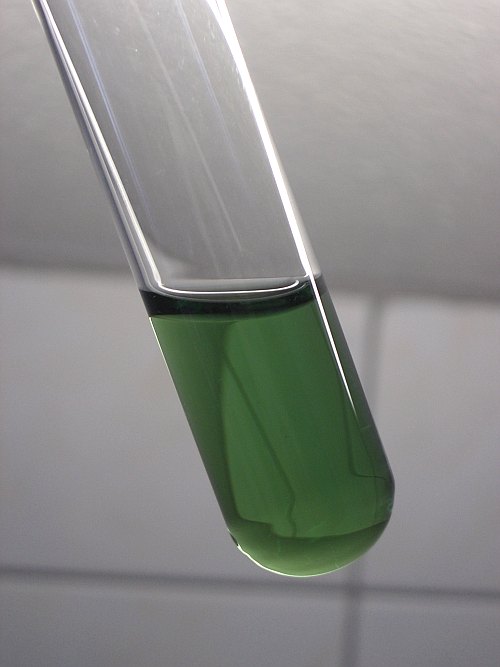
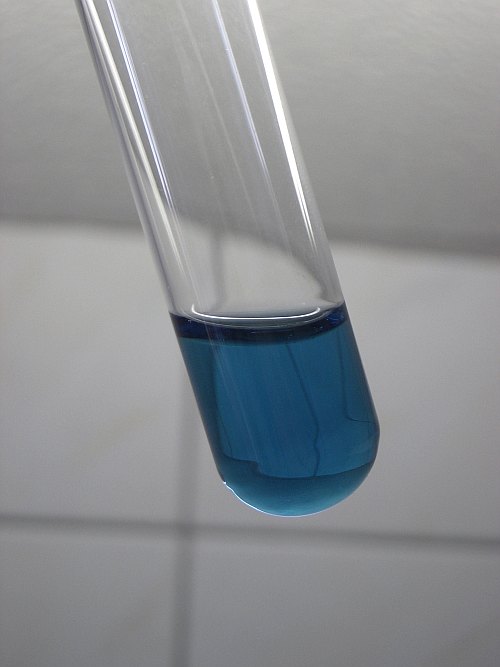
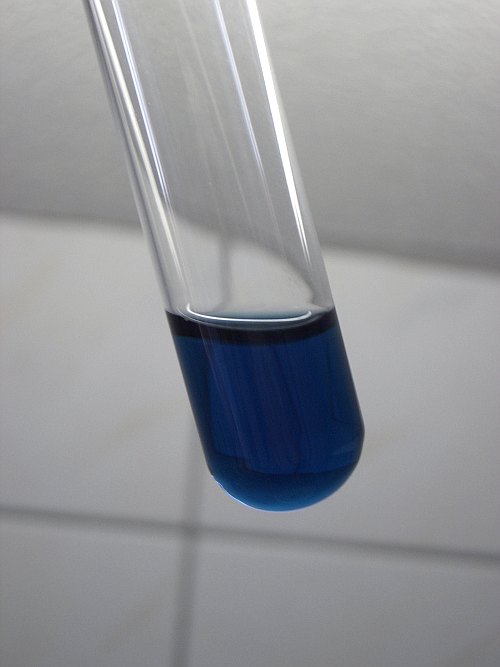
A few simple experiments are given, leading to different colors, all starting from colorless solutions.
![]()
![]() Required
chemicals:
Required
chemicals:
-
molybdenum trioxide
-
ascorbic acid
-
sodium hypophosphite
-
sodium hydroxide
-
dilute sulphuric acid
-
sodium peroxodisulfate
-
hydrogen peroxide (3%)
![]() Required
equipment:
Required
equipment:
-
test tubes
-
burner for heating the test tubes
![]() Safety:
Safety:
This set of experiments is not particularly dangerous, but it is good to keep in mind the following safety issues.
- Molybdenum compounds are somewhat toxic, avoid exposure of skin and eyes.
- Sodium hydroxide is very corrosive to skin and eyes. If some of this comes in contact with the skin, immediately rinse with cold water and keep rinsing until the slippery feeling disappears. At any cost one should avoid getting this chemical in the eye, this instantly will lead to severe damage or even blindness.
- Dilute sulphuric acid is corrosive, avoid contact with skin and eyes.
![]() Disposal:
Disposal:
- The molybdenum waste should not be flushed down the drain, but should be treated as heavy metal waste.
![]()
Preparation of the starting solution
For all of the experiments from this page, an alkaline solution of sodium molybdate is used as starting solution. This solution easily can be prepared from molybdenum trioxide and sodium hydroxide.
Put some molybdenum trioxide in a test tube and add a solution of sodium hydroxide to this. Swirl the test tube, until all solid has dissolved. The solid fairly easily dissolves. The pictures below show the dry powder and the powder under a layer of freshly prepared solution of sodium hydroxide.
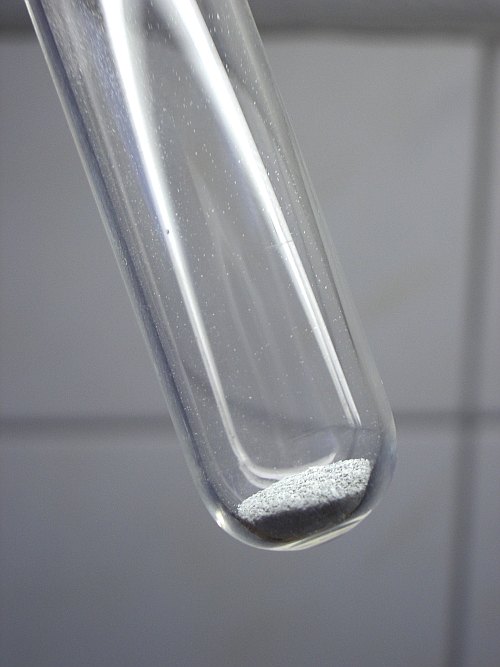
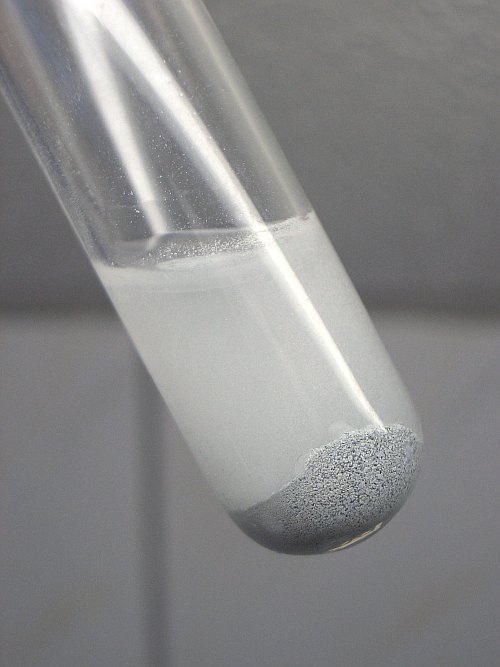
After some swirling, all of the solid dissolves and a clear and colorless liquid is obtained. If not all of the solid dissolves after minutes of swirling, then some more sodium hydroxide needs to be added.
The clear liquid should be diluted somewhat and the final dilute liquid is used as starting point for all experiments on this webpage. The two pictures below show the clear liquid and the dilution.
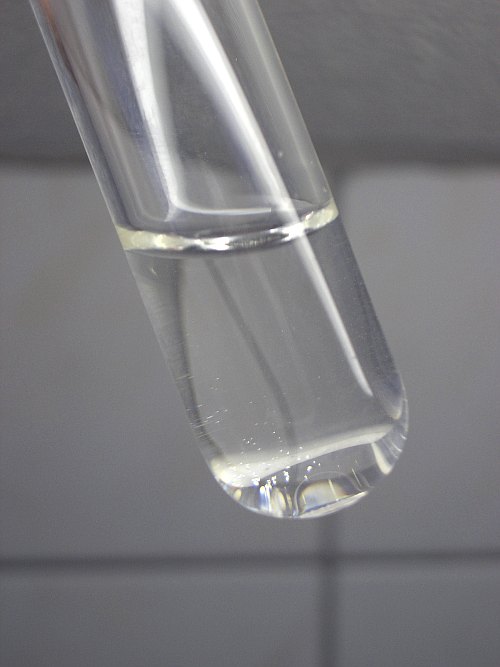
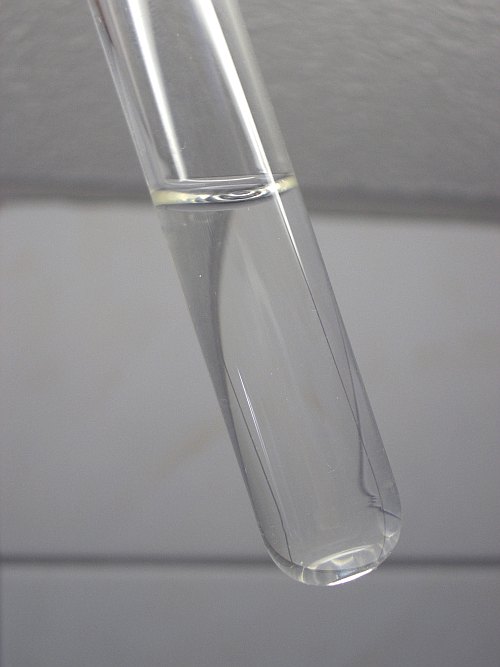
This colorless solution looks rather dull and uninteresting. It contains molybdenum in the +6 oxidation state. Interesting things happen when the compound is reduced, or when complexes are formed with the molybdenum.
![]()
Colorful complex and redox chemistry with ascorbic acid
Ascorbic acid forms a beautiful deep yellow complex with molybdate ions, and under certain conditions this same chemical is capable of reducing the molybdenum from +6 to a lower oxidation state, which leads to formation of blue compounds. The mix of the yellow complex and the blue product of reduction leads to all kinds of greens.
The behavior of the molybdate/ascorbate system also strongly depends on pH. This difference is demonstrated here as well.
Ascorbic acid with extra acid added
In this experiment, some of the colorless sodium molybdate solution is taken and to this, an acidified solution of ascorbic acid is added. The solution of ascorbic acid is acidified so much, that the mix of the sodium molybdate solution and the ascorbic acid solution always remains on the acidic side of the pH-scale.
Immediately after mixing some of the acidified solution of ascorbic acid (this solution is colorless) and the sodium molybdate solution, a yellow and clear liquid is obtained:
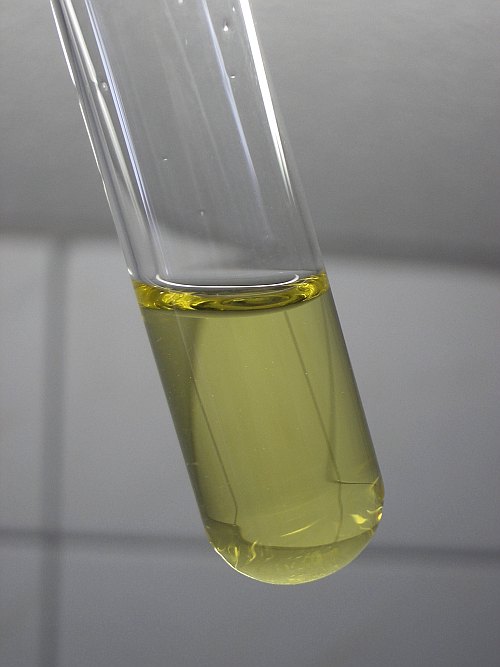
This is the color of the molybdate/ascorbate complex. Molybdenum is known for formation of complexes with anionic species. Best known is the yellow phosphate/molybdate complex, but many other complexes are known. These molybdate complexes all are yellow. They contain molybdenum in the +6 oxidation state.
When this yellow solution is heated, then the ascorbic acid reduces the molybdenum from +6 to a lower oxidation state. This leads to formation of the so-called molybdenum blues, which in combination with the yellow color of the molybdate/ascorbate complex leads to all kinds of greens.
The three pictures below show how the color shifts from green to dark blue, when the molybdenum is reduced more and more.

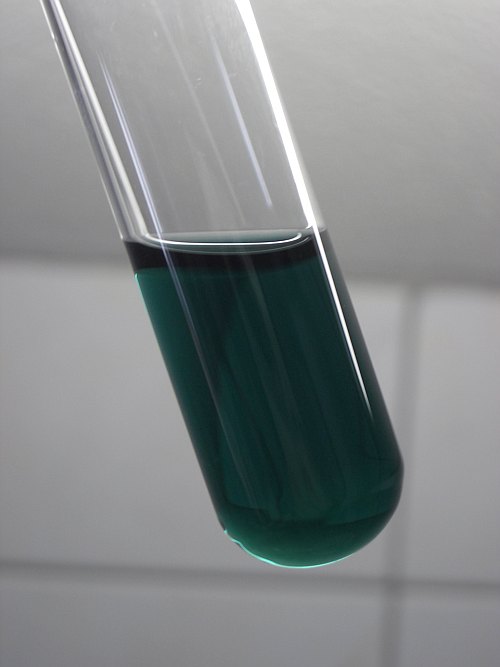
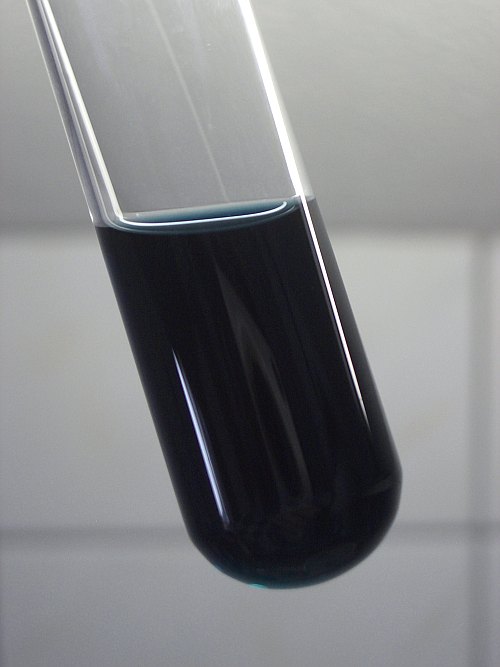
The final situation is that a very dark blue liquid is obtained. The picture below shows the deep color. Some light from a fluorescent tube is passing through the liquid and this demonstrates the blue color.
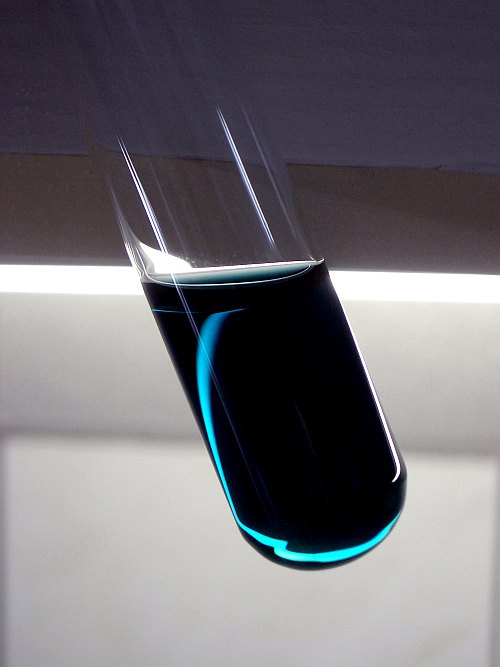
When the dark blue liquid is allowed to stand for a longer time, then it becomes even darker and the color shifts more towards blue. The picture above still shows some cyan/green color, but in the long end, a pure blue color remains. The picture below shows an erlenmeyer with 100 ml of water, in which the contents of the test tube is poured.
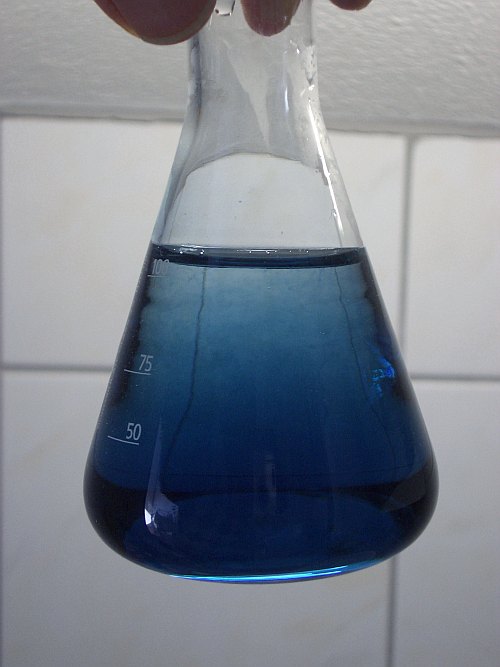
Ascorbate and extra sodium hydroxide added
Totally different results are obtained when ascorbic acid is dissolved in excess solution of sodium hydroxide. When this colorless solution is mixed with some of the colorless sodium molybdate solution, then again a yellow liquid is obtained, just as with the acidic solution. This yellow liquid has a faint orange hue, while the initial yellow acidic liquid has a faint green hue.

When this liquid is heated, then again a change of color occurs, but now the color changes from yellow to deep red/brown, through shades of orange.


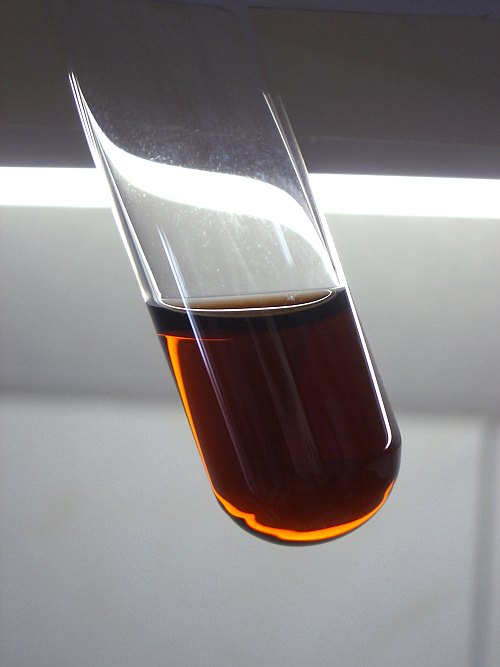
Probably, both the alkaline and acidic liquids initially contain a molybdate/ascorbate complex, which is yellow. The slightly different hues of the two initial liquids can be explained by assuming that the change of color (from yellow to blue in acidic solution and from yellow to red in alkaline solution) already has started somewhat when the picture was made.
![]()
Reduction of molybdate with hypophosphorous acid
When molybdate ion is reduced by a non-coordinating reductor, then a purely blue liquid is obtained, due to formation of the so-called molybdenum blues.
Initially, when a solution of sodium molybdate is mixed with a fairly strongly acidified solution of sodium hypophosphite, then a colorless solution is obtained. Even when this is heated, initially nothing seems to happen. But slowly (much more slowly than with ascorbic acid) the color changes from colorless to faint blue and when this starts, then over a period of several minutes, the color slowly intensifies. At the end (after quite some time of heating) the liquid has become deep blue. The final picture shows the light from a fluorescent tube, passing through the very dark blue liquid.


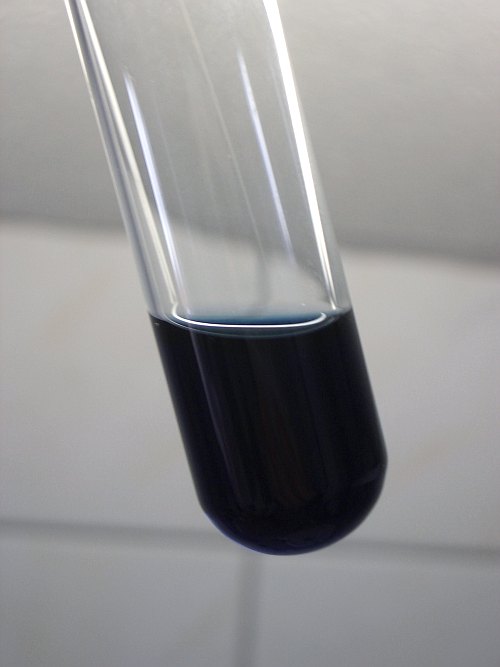
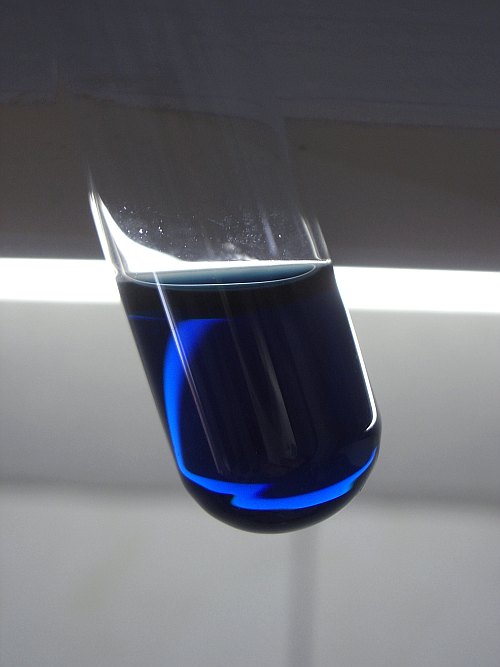
A nice experiment is to oxidize the molybdenum blue to molybdate(VI) again with peroxodisulfate ion. When this is done, then remarkably, no colorless liquid is obtained (not even with a large excess of oxidizer, nor with heating), but a greyish/green liquid is obtained. The pictures below show the result of adding a lot of solid Na2S2O8 to the dark blue liquid and heating this. The color of the liquid fairly quickly fades, but it does not become totally white, as shown by the right picture. The turbidity is due to the large amount of solid persulfate added. Not all of the solid can be dissolved.
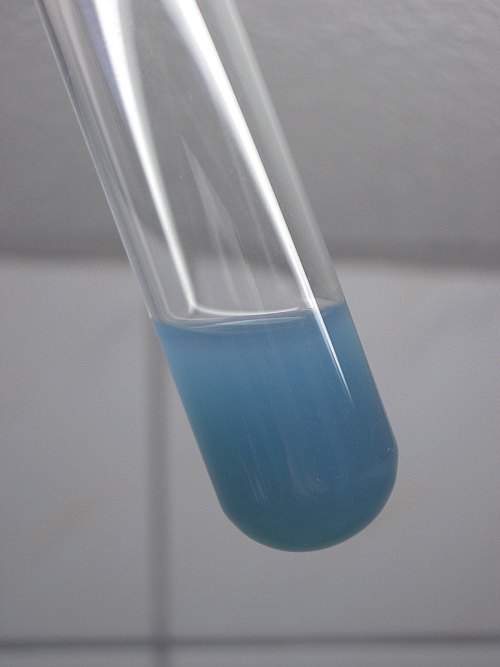
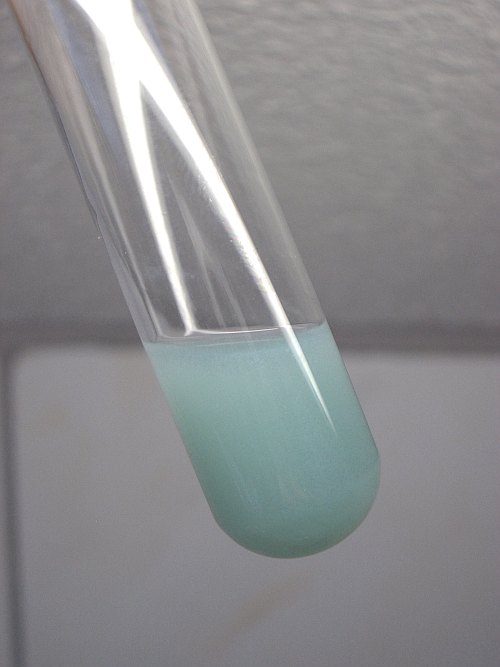
An interesting result is obtained when a large amount of 3% hydrogen peroxide is added. The color shifts towards yellow at once. This is the color of the molybdate(VI)/peroxo complex. All remains of the blue/green color disappear at once on addition of hydrogen peroxide.
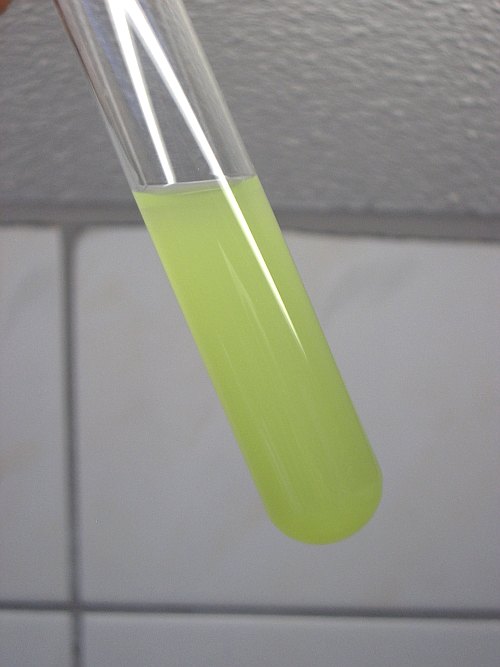
![]()
Discussion of results
Molybdate ions form complexes with many other anionic species and most likely this also is the case with ascorbic acid or ascorbate. This could explain the immediate formation of a yellow liquid when ascorbic acid is added to a solution of sodium molybdate. This happens both at high and low pH.
Reduction of molybdate in acidic solution leads to formation of so-called molybdenum blues. The precise nature of these blue compounds is not known, but it generally is accepted that it is some mixed oxidation state compound (molybdenum in +6 oxidation state and +5 oxidation state in a single complicated ion or molecule). The blue material can be in solution, but it can also be colloidal.
The green colors can be explained by mixing the yellow of the molybdate/ascorbate complex and the blue of the molybdenum blues.
With hypophosphorous acid used as reductor, no complex formation occurs and one obtains the pure blue color of the molybdenum blue.
The yellow color of the final picture is due to the presence of a peroxo complex of molybdate at low pH. A peroxo-molybdate(VI) complex is yellow at low pH and red at high pH.
Unfortunately no more details can be given about the chemical background of the observed colors. No precise formula is known for the ascorbate/molybdate complex and the same is true for the molybdenum blue and peroxo complex. It might be that these are known somewhere, but not to the author of this web page.